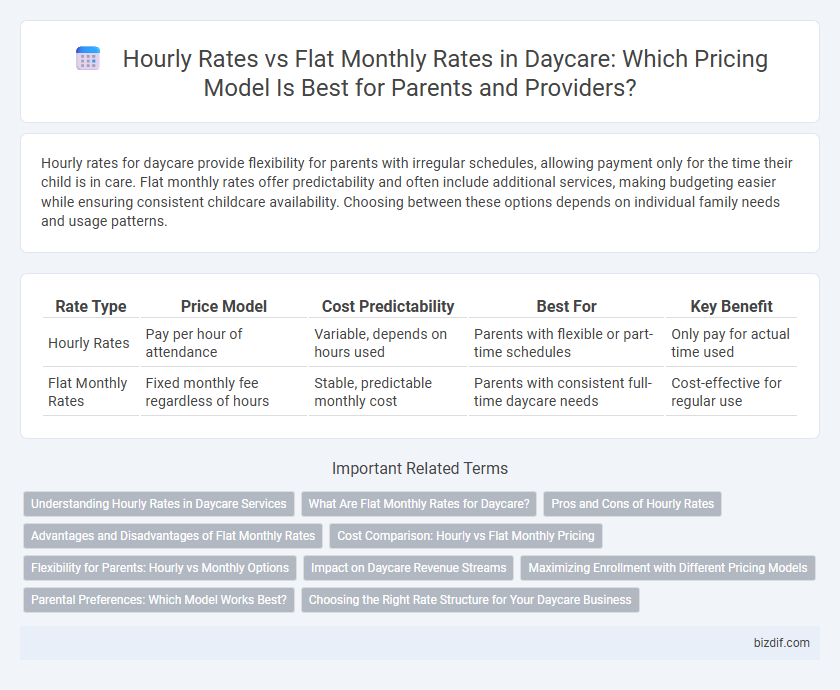Hourly rates for daycare provide flexibility for parents with irregular schedules, allowing payment only for the time their child is in care. Flat monthly rates offer predictability and often include additional services, making budgeting easier while ensuring consistent childcare availability. Choosing between these options depends on individual family needs and usage patterns.
Table of Comparison
| Rate Type | Price Model | Cost Predictability | Best For | Key Benefit |
|---|---|---|---|---|
| Hourly Rates | Pay per hour of attendance | Variable, depends on hours used | Parents with flexible or part-time schedules | Only pay for actual time used |
| Flat Monthly Rates | Fixed monthly fee regardless of hours | Stable, predictable monthly cost | Parents with consistent full-time daycare needs | Cost-effective for regular use |
Understanding Hourly Rates in Daycare Services
Hourly rates in daycare services offer families flexible childcare options by charging based on the exact hours their children attend, allowing for cost-efficiency when care is needed intermittently. These rates can vary widely depending on location, provider qualifications, and the level of care, typically ranging from $8 to $20 per hour in urban areas. Understanding these rates helps parents budget according to their unique schedules, especially beneficial for part-time care or irregular hours.
What Are Flat Monthly Rates for Daycare?
Flat monthly rates for daycare provide a consistent, fixed fee for childcare services regardless of the number of hours attended, simplifying budgeting for families. These rates often cover full-time care, including meals, activities, and extra services, making them a comprehensive option compared to hourly rates that vary based on actual attendance. Many daycares offer flat monthly rates to ensure predictable childcare costs and to encourage full enrollment.
Pros and Cons of Hourly Rates
Hourly rates in daycare offer flexible payment based on actual usage, benefiting parents with irregular schedules by avoiding charges for unused time. However, fluctuating costs can make budgeting difficult, and hourly billing may be less cost-effective for families needing consistent, long-term care. Providers might face administrative challenges tracking hours accurately, impacting operational efficiency.
Advantages and Disadvantages of Flat Monthly Rates
Flat monthly rates for daycare offer predictable budgeting and often lower overall costs for families requiring consistent care, eliminating hourly rate fluctuations. However, they may result in paying for unused hours if a child's attendance varies, reducing cost efficiency for irregular schedules. Providers benefit from steady income streams but may face challenges accommodating fluctuating daily attendance within fixed pricing.
Cost Comparison: Hourly vs Flat Monthly Pricing
Hourly rates for daycare provide flexibility and may be cost-effective for parents with irregular schedules, typically ranging from $10 to $30 per hour depending on location and facility quality. Flat monthly rates, often between $800 and $1,500, offer predictable expenses and unlimited care but might be less economical for families needing fewer hours. Careful comparison of total monthly hours needed against rate structures helps determine the most affordable option for individual childcare needs.
Flexibility for Parents: Hourly vs Monthly Options
Hourly daycare rates offer parents greater flexibility, allowing them to pay only for the exact hours their child attends, ideal for irregular schedules or part-time care. Flat monthly rates provide a consistent, predictable expense, benefiting families with steady, full-time childcare needs. Choosing between hourly and monthly payment plans depends on balancing budget predictability with adaptability to varying childcare demands.
Impact on Daycare Revenue Streams
Hourly rates offer flexibility, attracting parents who require sporadic childcare and potentially increasing short-term revenue fluctuations for daycare centers. Flat monthly rates provide consistent, predictable income, stabilizing cash flow and enabling better financial planning and resource allocation. Mixing both pricing models can optimize revenue streams by balancing steady earnings with opportunities for higher short-term gains.
Maximizing Enrollment with Different Pricing Models
Daycare centers can maximize enrollment by offering flexible pricing models such as hourly rates and flat monthly rates tailored to different family needs. Hourly rates attract parents seeking occasional care, making the service more accessible and cost-effective for short-term use. Flat monthly rates provide predictability and convenience for families requiring consistent full-time care, encouraging longer commitments and stable revenue streams.
Parental Preferences: Which Model Works Best?
Parental preferences for daycare pricing models vary, with many valuing flat monthly rates for budgeting predictability and consistent childcare access. Hourly rates appeal to parents with irregular schedules or limited childcare needs, offering flexibility and potential cost savings. Understanding the balance between these models helps daycare providers tailor services to meet diverse family demands and enhance satisfaction.
Choosing the Right Rate Structure for Your Daycare Business
Choosing the right rate structure for your daycare business depends on your target market and operational costs. Hourly rates offer flexibility for parents with irregular schedules and can attract part-time clients, while flat monthly rates provide predictable revenue and simplify budgeting for both providers and families. Analyzing local competition and understanding parental preferences will help determine whether hourly or flat monthly rates optimize enrollment and profitability.
Hourly rates vs flat monthly rates Infographic

 bizdif.com
bizdif.com